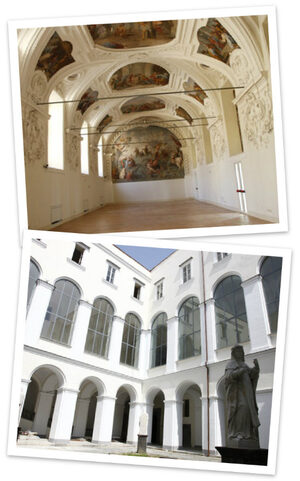St. Domenico Maggiore Convent
New opening hours

- click to zoom
The St. Domenico Maggiore Convent, which together with the Church creates a very important complex, is the result of centuries of stratification that started in 1227 when Pope Gregory IX sent to Naples a group of Dominicans, who settled in the former St. Michael the Archangel Monastery in Morfisa. Thomas Aquinas lived in the convent between 1272 and 1274, he thought theology at the "Studium" established by Charles I of Anjou. In 1289 the renovation of the Convent was started. The convent reached its highest development thank to the works started in 1669 by the Prior Tommaso Ruffo of the Dukes of Bagnara. Indeed, the building was four times bigger than the cityitself, for this reason, people considered the complex as a city within a city.
The Prior Ruffo, who contributed to the costs of the renovation, wanted to preserve some area linked to the story of the complex, as for instance Thomas Aquinas's cell. The renovation continued until the 17th century. The works were mainly divided into three branches: St. Thomas' dormitory, Masters' novitiate and dormitory, which were arranged around an area designed as a garden. Near St. Thoma's dormitory there were the Refectory, on the first floor, the Capitolo Hall and the Library. The architects who worked at the Convent were Bonaventura Presti, Francesco Antonio Picchiatti and Luigi Nauclerio. Today the convent is divided into different areas. One of them is used by Dominicans, the area at the same level of the cloister is a gym, another area hosts a school, while the most important section, that till the '90s hosted the former CorteD'Assie, is nowadays under renovation.
The renovation of the Convent tries to reproduce the ancient style of the Monastery, recreating the original architectural features and spaces, the connections between the spaces and the typological characteristics countersign them. Great importance was given to the decorative part of the Convent. The elements restored were the paintings, the stucco, St. Thomas's Cell, which was entirely decorated duringthe 18th century, and all the furniture as for instance the liturgical machine for the Forty Hours's Devotion, that will surely represent one of the most important symbol of the museum.
THE RESTORED ARES
The big refectory
The small refectory
Capitolo Hall
The hall of the Library
The corridor and St. Thomas' cell
Where: Via San Domenico Maggiore, 18 Naples
When: from Monday to Friday from 10.00 am to 5.00pm
Free admission Info: 081 7956160
How to get: underground line 1 - stop: Museo
Contacts: Cultural Association NeartPolis tel. 338 1865180 e-mail - neartpolis@libero.it